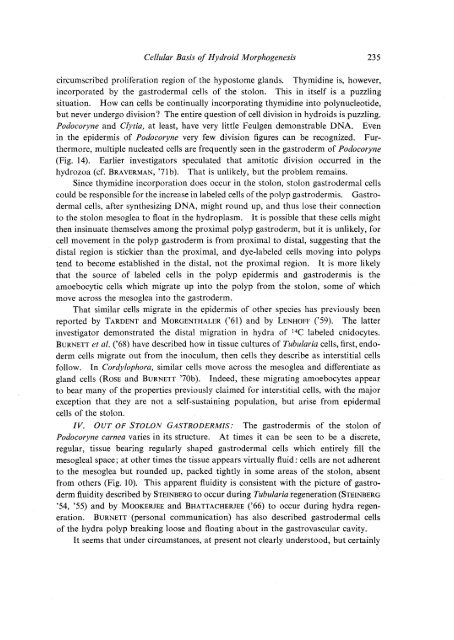THE CELLULAR BASIS OF HYDROID MORPHOGENESIS
THE CELLULAR BASIS OF HYDROID MORPHOGENESIS
THE CELLULAR BASIS OF HYDROID MORPHOGENESIS
You also want an ePaper? Increase the reach of your titles
YUMPU automatically turns print PDFs into web optimized ePapers that Google loves.
Cellular Basis of Hydroid Morphogenesis 235<br />
circumscribed proliferation region of the hypostome glands. Thymidine is, however,<br />
incorporated by the gastrodermal cells of the stolon. This in itself is a puzzling<br />
situation. How can cells be continually incorporating thymidine into polynucleotide,<br />
but never undergo division? The entire question of cell division in hydroids is puzzling.<br />
Podocoryne and Clytia, at least, have very little Feulgen demonstrable DNA. Even<br />
in the epidermis of Podocoryne very few division figures can be recognized. Furthermore,<br />
multiple nucleated cells are frequently seen in the gastroderm of Podocoryne<br />
(Fig. 14). Earlier investigators speculated that amitotic division occurred in the<br />
hydrozoa (cf. BRAVERMAN, '71b). That is unlikely, but the problem remains.<br />
Since thymidine incorporation does occur in the stolon, stolon gastrodermal cells<br />
could be responsible for the increase in labeled cells of the polyp gastrodermis. Gastrodermal<br />
cells, after synthesizing DNA, might round up, and thus lose their connection<br />
to the stolon mesoglea to float in the hydroplasm. It is possible that these cells might<br />
then insinuate themselves among the proximal polyp gastroderm, but it is unlikely, for<br />
cell movement in the polyp gastroderm is from proximal to distal, suggesting that the<br />
distal region is stickier than the proximal, and dye-labeled cells moving into polyps<br />
tend to become established in the distal, not the proximal region. It is more likely<br />
that the source of labeled cells in the polyp epidermis and gastrodermis is the<br />
amoebocytic cells which migrate up into the polyp from the stolon, some of which<br />
move across the mesoglea into the gastroderm.<br />
That similar cells migrate in the epidermis of other species has previously been<br />
reported by TARDENT and MORGENTHALER ('61) and by LENH<strong>OF</strong>F ('59). The latter<br />
investigator demonstrated the distal migration in hydra of 14 C labeled cnidocytes.<br />
BuRNETT et al. ('68) have described how in tissue cultures of Tubularia cells, first, endoderm<br />
cells migrate out from the inoculum, then cells they describe as interstitial cells<br />
follow. In Cordylophora, similar cells move across the mesoglea and differentiate as<br />
gland cells (RosE and BURNETT '70b).<br />
Indeed, these migrating amoebocytes appear<br />
to bear many of the properties previously claimed for interstitial cells, with the major<br />
exception that they are not a self-sustaining population, but arise from epidermal<br />
cells of the stolon.<br />
IV. OUT <strong>OF</strong> STOLON GASTRODERMIS: The gastrodermis of the stolon of<br />
Podocoryne carnea varies in its structure. At times it can be seen to be a discrete,<br />
regular, tissue bearing regularly shaped gastrodermal cells which entirely fill the<br />
mesogleal space; at other times the tissue appears virtually fluid: cells are not adherent<br />
to the mesoglea but rounded up, packed tightly in some areas of the stolon, absent<br />
from others (Fig. 10). This apparent fluidity is consistent with the picture of gastroderm<br />
fluidity described by STEINBERG to occur during Tubularia regeneration (STEINBERG<br />
'54, '55) and by MooKERJEE and BHATTACHERJEE ('66) to occur during hydra regeneration.<br />
BURNETT· (personal communication) has also described gastrodermal cells<br />
of the hydra polyp breaking loose and floating about in the gastrovascular cavity.<br />
It seems that under circumstances, at present not clearly understood, but certainly

















